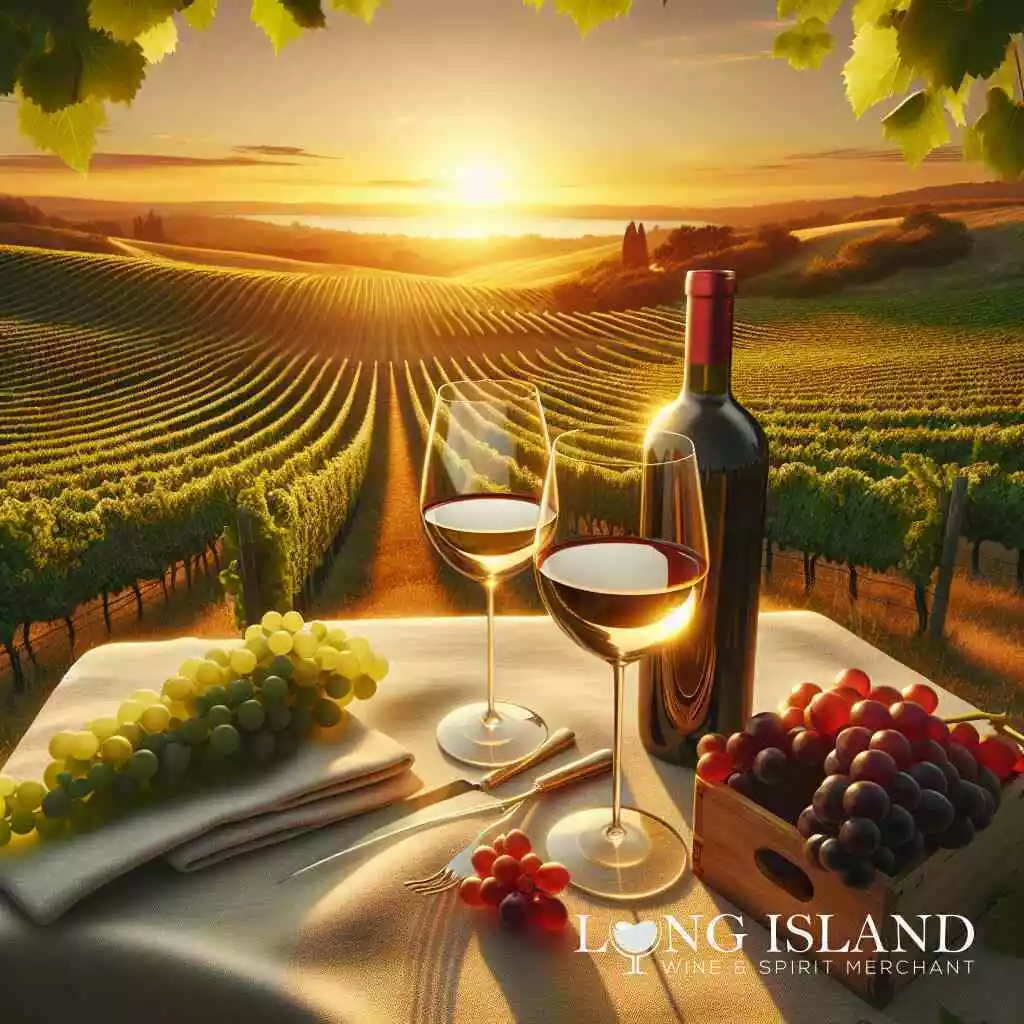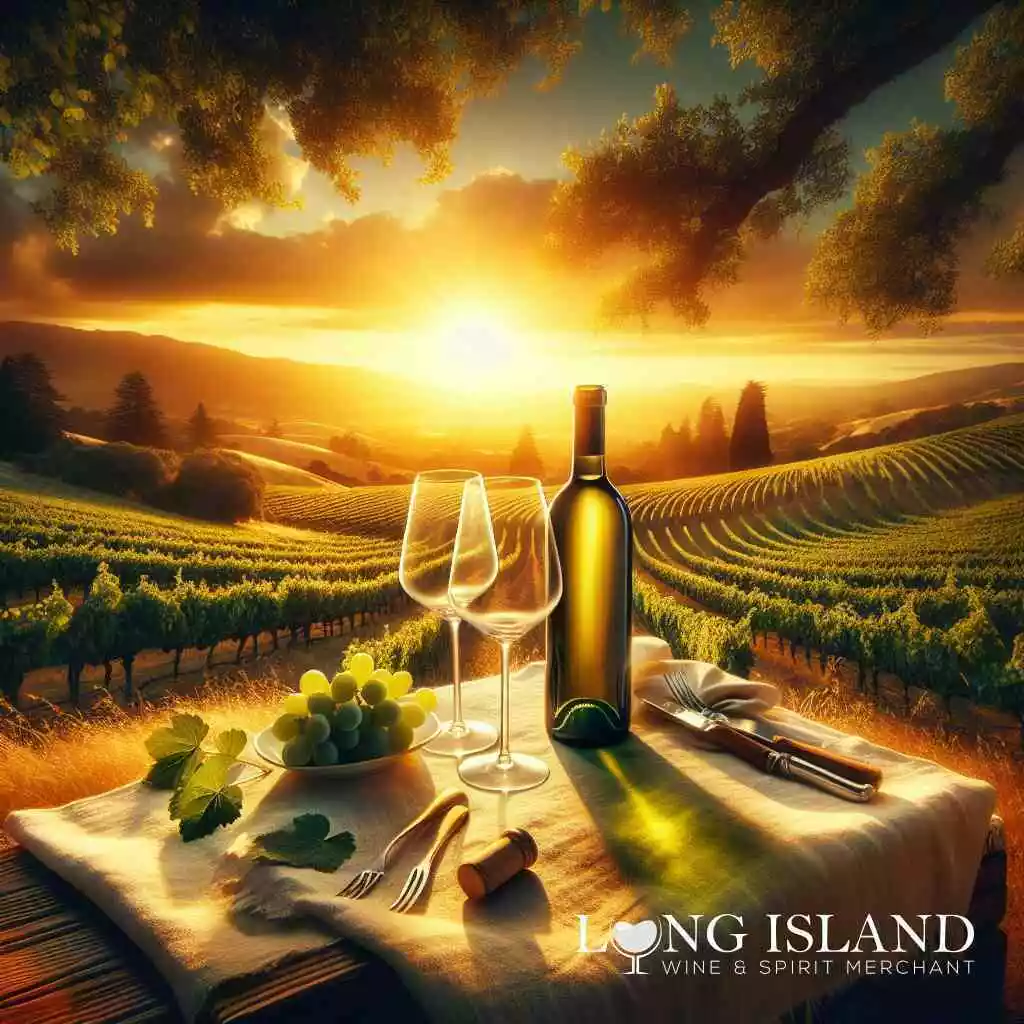
The Difference Between Red and White Wine
August 12, 2024
Introduction to the Worlds of Red and White Wine
Understanding Wine Basics
Wine, a cherished beverage with millennia of history, captivates connoisseurs and casual drinkers alike with its vast array of flavors, textures, and aromas. At its core, wine is a fermented grape drink, but this simple definition barely scratches the surface of its complexity and variety. The journey from vine to glass involves numerous steps, each of which plays a crucial role in developing the wine’s ultimate character. Decisions made during the viticulture and vinification processes significantly influence whether a wine will tantalize with the robustness of red or enchant with the crispness of white.
Overview of Wine Color Varieties
The color of wine is one of the first characteristics noticed by both the novice and the experienced wine enthusiast. This visual trait not only hints at the wine’s grape variety but also suggests the methods used in its creation. Generally speaking, red wines owe their deeper hues to extended contact with grape skins during fermentation, a process that also introduces a range of complex flavors and tannins. White wines, in contrast, are produced with minimal contact with the skins, resulting in lighter colors and a profile that tends towards brighter, fruitier notes. Between these two poles lie rosé wines, with colors that hint at the varied techniques of skin contact used in their production.
Long Island Wine Selection
The Long Island wine shop, nestled in the heart of one of New York’s most celebrated wine-producing regions, offers a microcosm of the broader world of wine. Long Island’s maritime climate and well-drained soils provide an ideal environment for growing a diverse range of grape varieties, enabling local vintners to craft both red and white wines of exceptional quality. The selection available mirrors this diversity, with bottles showcasing the best of both local and international vineyards. Guide to Finding Best Liquor Deals Near Me Whether you’re drawn to the robust, oak-aged complexity of a Long Island red or the crisp, refreshing clarity of a white, exploring the wine selection near Long Island promises a rewarding journey through the world of wines.
The Viticulture of Red and White Grapes
Wine Grapes Varietals
In the lush vineyards that dot the landscape of regions like Long Island, the diversity of wine grape varietals is both astounding and enlightening. At the Long Island Wine & Spirit Merchant, enthusiasts and newcomers alike can uncover the myriad types of grapes that give red and white wines their distinctive characteristics. Red wine varieties, including Cabernet Sauvignon, Merlot, and Pinot Noir, are known for their bold flavors and deep colors. White wine grapes, such as Chardonnay, Sauvignon Blanc, and Riesling, offer a lighter, more delicate profile. Each variety brings its own unique set of aromas, flavors, and textures to the wines they produce, influenced by the terroir in which they are grown.
Cultivation and Harvest Differences
The cultivation and harvest of wine grapes involve meticulous planning and labor-intensive care, and the methods often differ significantly between red and white varietals. Red grapes typically require a warmer climate to ripen and develop their rich flavors and deep colors fully. In contrast, white grapes thrive in cooler conditions, where they can retain their acidity and fresh, fruity notes. Harvest timing is critical: red grapes are often left on the vine longer to achieve a higher concentration of sugars and flavors, while white grapes are harvested earlier to preserve their acidity and freshness. This delicate balance ensures that each bottle of wine from Long Island encapsulates the essence of its grape varietal and the unique characteristics of its vintage.
Impact of Climate on Grape Types
The climate plays a pivotal role in shaping the character of wine grapes. Long Island’s unique maritime climate, with its moderate temperatures and extended growing season, provides an ideal environment for a wide range of both red and white varieties. Red grapes benefit from warm, sunny days to develop their complex flavors and robust tannins. At the same time, the cool, breezy nights allow white grapes to maintain their crisp acidity and aromatic quality. This interplay between warm days and cool nights is a hallmark of fine wine regions and is intimately connected to the distinct profiles of Long Island wines. Whether it’s a full-bodied red or a vibrant white, the influence of climate is evident in the glass, offering a taste of the terroir that is both profound and memorable. Top 10 Spring Wines for 2024 in Long Island
In exploring the viticulture of red and white grapes, it becomes clear that the journey from vineyard to wine glass is filled with intricate decisions and processes. By understanding the varieties, cultivation practices, and climatic influences that distinguish red and white wines, connoisseurs and casual drinkers alike can deepen their appreciation for the art and science of winemaking.
The Vinification Process: From Grape to Glass
Wine Making Process
The journey from grape to glass is a fascinating tale of nature combined with the art of winemaking. At the heart of the Long Island Liquor Store’s impressive wine selection near Long Island, each bottle begins its life in the vineyard but reaches its zenith in the winery. Vinification, the process of turning grapes into wine, is steeped in tradition yet embraces modern innovation. Grapes are harvested when they reach optimal ripeness, a decision that can vary significantly between regions, vineyards, and even within a single vineyard block. The harvested grapes are then sorted, destemmed, and crushed. This initial stage sets the stage for fermentation, where the sugar in the grape juice is converted into alcohol by yeast, creating wine. The intricacies of vinification differ markedly between red and white wines, with the duration of fermentation, temperature control, and intervention by the winemaker playing pivotal roles in shaping the wine’s character.
Red vs. White Wine Fermentation
Diving deeper into the fermentation process reveals the fundamental distinctions between red and white winemaking. Red wines are fermented with grape skins and seeds, allowing the resultant wines to imbibe a plethora of compounds, including tannins, anthocyanins, and various flavor and aroma compounds. This skin contact gives red wines their characteristic color, complexity, and structure. The fermentation of red wines often occurs at higher temperatures, typically between 68°F to 86°F (20°C to 30°C), facilitating a thorough extraction of color and tannins. On the other side, white wines are pressed after crushing to separate the juice from the skins and seeds before fermentation, preventing the transfer of color and minimizing tannin extraction. White wine fermentation is performed at cooler temperatures, usually between 50°F to 64°F (10°C to 18°C), to preserve the delicate aroma and flavor profiles inherent to white wine grapes. The stark contrast in fermentation techniques underscores the nuanced approach required to craft the diverse array of red and white wines that grace the shelves of Long Island Liquor Store.
Skin Contact Wine Techniques
Skin contact is a term often relegated to the realm of red winemaking, but it also plays a crucial role in the production of certain white wines, imparting them with depth and complexity. This technique, known as maceration, is the practice of letting the grape juice interact with the skins. While red wine production is a standard procedure, white winemaking is a less common but increasingly appreciated method used to craft unique style wines such as orange wines. These are white wines that have been left in contact with the skins for a period, gaining color, flavor, and texture that wouldn’t be present in traditional white wines. The Long Island Wine & Spirit Merchants wine room showcases examples of both conventional and innovative winemaking approaches, including fine wines and good spirits created through diverse skin contact techniques.
In exploring the vinification process from grape to glass, one gains an appreciation for the meticulous and thoughtful journey undertaken to produce each bottle of wine. How to Choose the Perfect Long Island Brandy? From the selection of grapes through to the intricate fermentation processes differing between red and white wines, and finally, to the innovative techniques like skin contact, the craft of winemaking is both an art and a science. Long Island Liquor Store prides itself on offering a wine selection that encapsulates this breadth of tradition and innovation, inviting both connoisseurs and casual drinkers to explore the nuanced world of wine.
The Chemical and Sensory Differences
Tannins in Wine
Tannins, a group of bitter and astringent compounds, play a pivotal role in the sensory profile of red wines, distinguishing them significantly from their white counterparts. These compounds are primarily found in the grape skins, seeds, and stems, which is why red wines, which ferment with skin contact, exhibit higher levels of tannins. The presence of tannins in red wine contributes to the wine’s structure and longevity, offering a sensation that can range from velvet-like smoothness in mature wines to a more robust and astringent feel in younger wines. Exploring the Long Island Wine & Spirit Merchants wine room, one can find a diverse selection of red wines, each with its unique tannin profile reflective of its grape variety and winemaking practices, providing a tactile journey through the world of wine.
Wine Acidity and Sugar Content
Acidity is another crucial determinant of a wine’s character, influencing its tartness and freshness. Both red and white wines possess acidity, but the levels and perception can drastically differ due to the varietal characteristics and winemaking techniques. White wines are often celebrated for their crisp acidity, enhancing their refreshing quality. This is partly why white wines retain a bright, refreshing character, especially evident in varietals like Sauvignon Blanc and Riesling, which are known for their zesty acidity. On the sugar front, wines can range from bone-dry to sweet, depending on the fermentation process. While sugar content is more often discussed in the context of white and dessert wines, some red wines also feature residual sugars, contributing to their overall balance and flavor profile. Long Island Liquor Store, with its expansive wine selection, offers an educational palate experience, demonstrating how acidity and sugar content vary across different wines and styles.
Wine Phenolic Compounds
Phenolic compounds in wine, including flavonoids and non-flavonoids, are critical to the beverage’s flavor, color, and texture. Red wines are particularly rich in phenols due to the extended skin contact during the fermentation process, leading to a complexity of flavors and a deeper color. These compounds are also responsible for the wine’s antioxidant properties, contributing to the health benefits associated with moderate red wine consumption. White wines, though lower in phenolic content, possess their own set of phenolic compounds that contribute to their flavor profiles and potential health benefits. Engaging with the knowledgeable staff at Long Island Liquor Store or exploring their selection can provide insights into how these compounds manifest in both the taste and therapeutic qualities of different wines, accentuating the enjoyment of wine tasting and appreciation.
Exploring Wine Aroma, Texture, and Flavor
Wine Aroma Profiles
Wine’s aromatic complexity is one of its most enchanting qualities, offering a sensory prelude to flavor that can transport the drinker to vineyards far and wide. Red and white wines possess distinctly different aroma profiles shaped by their grape varieties, fermentation processes, and aging. Red wines often boast aromas of dark fruits like cherry and berry, accented by earthy and spicy undertones, a testament to their skin contact during vinification. On the other hand, white wines are celebrated for their lighter, fresher scents, with notes of citrus, green apple, and floral bouquets that reflect their cooler fermentation techniques. Exploring the wine selection at Long Island Wine & Spirit Merchant, enthusiasts can embark on an aromatic journey, appreciating the subtle craft that imbues each varietal with its distinctive bouquet.
Wine Body and Texture Variations
The body of a wine, felt as its weight or fullness on the palate, varies significantly between reds and whites, adding to the richness of the wine-tasting experience. Red wines, by virtue of their tannin structure and higher alcohol content, often present a fuller body, ranging from medium to full-bodied, attributing to a sense of warmth and richness. Whites, conversely, tend to lean towards light to medium-bodied profiles, providing a crisp and refreshing contrast. Texture, closely related to the body, is influenced by factors such as acidity and effervescence. For instance, white wines might offer a zesty tartness or a creamy smoothness in the case of those aged on lees. By consulting with the wine experts at Long Island Liquor Store, patrons can discover wines that match their texture and body preference, enhancing the dining experience or simply the enjoyment of the wine itself. What Is the Best Liquor Store for Spirits Near Me?
Wine Flavor Profiles
The flavor profile of the wine is a complex interplay of its aroma and body, along with the taste on the palate, leaving a lasting impression long after the wine has been consumed. Red wines typically unfold flavors of ripe red and black fruits, chocolates, and spices, deepened by aging processes that introduce notes of vanilla and tobacco. White wines, in contrast, delight with a spectrum of flavors from crisp and fruity to rich and buttery, often illuminated by their acidity. Special attention in the vinification process, such as oak aging or malolactic fermentation, can further diversify the flavor profiles available within both red and white wines. Visitors to Long Island Liquor Store are invited to explore its wine selection, which showcases the vast array of flavor profiles available across different varieties and styles, guiding both the novice and connoisseur toward their perfect wine match.
Wine Aging, Storage, and Serving Recommendations
Wine Aging and Oak Influence
The journey of wine from vineyard to glass is a fascinating odyssey that doesn’t end at the bottle’s corking. Aging wine, particularly red varieties that benefit from the complex interplay of tannins and time, is an art that enhances its flavor, aroma, and overall character. Oak aging plays a monumental role in this process, offering a conduit for the wine to breathe, evolve, and acquire distinctive oak-derived attributes such as vanilla, caramel, and spice. This interaction with oak barrels instills in wine a multifaceted dimensionality that can’t be rushed.
At Long Island Liquor Store, the selection of aged wines is curated with a keen understanding of oak’s influence. It showcases the top dessert wines for 2024 on Long Island, where the depth of character acquired from oak aging becomes undeniably evident. Whether you’re exploring the mellow sophistication of an aged Chardonnay or the robust intensity of a Cabernet Sauvignon, the impact of time and timber is a testament to the wine’s journey.
Proper Wine Storage Techniques
To ensure that each bottle of wine reaches its zenith of flavor and quality, proper storage is paramount. Factors such as temperature, humidity, light exposure, and positioning play critical roles in the wine’s development or deterioration. Optimal conditions include storing wine at a consistent temperature around 55°F (13°C), with a humidity level that prevents corks from drying out while deterring mold growth. Darkness is also crucial, as UV rays can degrade and prematurely age wine, altering its intended flavor profile.
Long Island Liquor Store champions the importance of proper wine storage, offering insights and products that aid enthusiasts in creating ideal conditions at home. From specialized wine refrigerators to wine racks that encourage horizontal bottle placement, keeping the cork moist and the air out, every element is designed to preserve your wine’s integrity until the moment of uncorking.
Wine Serving Temperature and Glassware
The moment of serving wine is the culmination of anticipation and preparation, where temperature and glassware become crucial to the experience. Serving temperatures greatly influence the wine’s perceived flavors and aromas. Red wines, for instance, are best served slightly below room temperature, around 60°F to 68°F (15°C to 20°C), allowing their full spectrum of flavors to blossom. White wines flourish at cooler temperatures, between 45°F and 55°F (7°C to 13°C), which accentuate their crispness and aromatic qualities.
Equally important is the choice of glassware, which is designed to enhance the wine’s aroma and direct the wine to the optimal part of the mouth. Red wines benefit from larger bowls that provide ample surface area for aeration, while white wines are served in glasses with narrower bowls to concentrate their more delicate aromas.
The experts at Long Island Liquor Store are passionate about enriching your wine experience, guiding you through the selection of glassware, and sharing the nuances of wine serving temperatures. By engaging with their knowledge, you’re invited to elevate your wine enjoyment, ensuring each sip is as the winemaker intended.
Pairing Food with Red and White Wines
Wine Pairing Basics
Wine pairing is an art that complements and enhances both the dish and the drink. The Best Wine Pairings from Long Island Liquor Store At Long Island Liquor Store, we believe that understanding the fundamental principles can transform your dining experience. The key to successful wine pairing lies in balance and harmony; the wine should neither overpower the food nor be overshadowed by it. Factors such as the wine’s body, acidity, sweetness, and tannins need to be considered alongside the flavor, weight, and texture of the food. A basic rule of thumb is to match light foods with light wines and rich foods with fuller-bodied wines. However, don’t be afraid to experiment with contrasts, such as pairing a crisp white wine with a rich, creamy dish to cleanse the palate.
Red Wine Pairing Suggestions
Red wine, with its complex flavors and robust tannins, pairs beautifully with hearty, richly flavored dishes. For fans of red wine, Long Island Liquor Store recommends matching the intensity of the wine with the dish. A full-bodied red, such as a Cabernet Sauvignon, is a perfect companion to red meats like beef or lamb, magnifying the juiciness of the meat. Medium-bodied reds, such as Merlot or Pinot Noir, complement a wide range of foods, from roasted poultry to mushroom risotto. The key is to consider the dominant flavors of both the wine and the dish, aiming for a harmonious blend that highlights the best qualities of each.
White Wine Pairing Insights
White wines, known for their crisp acidity and fresh flavors, offer a delightful counterpoint to a variety of dishes. The Long Island Alcohol Store advises that light and zesty white wines, such as Sauvignon Blanc, pair wonderfully with salads, seafood, and dishes with bright, acidic sauces. Richer whites like Chardonnay, which may undergo oak aging, can stand up to creamier sauces and poultry. When pairing white wines, consider the wine’s acidity as a balancing element to the richness of the food, aiming for a combination that refreshes the palate and enhances the complexity of the flavors.
Cocktail Recipes Utilizing Wine
Wine isn’t just for sipping alongside your meal-it can also be a key ingredient in an array of creative cocktails. Long Island Liquor Store shares some innovative ideas for incorporating both red and white wines into your mixology repertoire. A classic Sangria combines red wine with fresh fruit, brandy, and a touch of sweetness, making it a perfect party beverage. For a refreshing twist, try a white wine spritzer, mixing white wine with sparkling water and a splash of citrus for a light, refreshing drink. Exploring cocktail recipes utilizing wine is a delightful way to enjoy the versatility of wine, both in your glass and on your plate. Whether hosting a sophisticated dinner party or enjoying a casual meal at home, the right wine pairing can elevate the occasion, turning a simple meal into an unforgettable culinary experience.
Selecting the Right Wine for You: Long Island Wine & Spirit Merchant Guidance
Wine Taste Quiz by Long Island Wine & Spirit Merchant
In the quest to navigate the extensive world of wines, the Long Island Wine & Spirit Merchant provides a unique tool: the Wine Taste Quiz. This innovative quiz is designed to understand your personal preferences and suggest wines that align with your taste. Whether you have a penchant for the bold and robust flavors of red wine or the crisp and refreshing notes of white, the quiz tailors its recommendations to suit your palate. By answering a series of questions about your flavor preferences, food pairing choices, and drinking occasions, the quiz offers a curated selection of wines from Long Island Liquor Store’s diverse inventory, making your next favorite wine a delightful experience.
Consulting with Wine Experts at Long Island Liquor Store
For a more personalized touch, consulting with the wine experts at Long Island Liquor Store elevates the experience of selecting the perfect wine. These seasoned professionals possess an intimate knowledge of the wine selection available, from the best red wines near me in 2024 on Long Island to the finest white wines that Commack has to offer. Whether you’re seeking a recommendation for a special occasion, pairing advice for an exquisite dinner, or an exploration into the world of rare and unique vintages, the expert team is equipped to guide you. Their insight ensures that every purchase not only meets but exceeds expectations, turning each sip into a memorable journey through Long Island’s finest.
Custom Case of Wine Options
Long Island Liquor Store goes beyond individual recommendations by offering the option to create a custom case of wine. This service allows wine enthusiasts to handpick a collection of wines tailored to their taste, occasion, or exploration goals. Selecting a case might involve mixing different varietals and regions or focusing on a singular type of wine to deepen one’s understanding and appreciation. Moreover, custom cases are an excellent way for businesses or individuals planning events to provide a sophisticated and personalized wine experience for guests. With access to Long Island Spirits’ extensive selection, creating a custom case becomes an opportunity to discover and enjoy the remarkable diversity of wines with convenience and confidence.
Beyond the Basics: Exploring Long Island’s Wine Selection
Exploring Long Island Red and White Wines
Long Island’s viticulture extends far beyond mere geography, embodying a dedication to quality and diversity that’s well-represented at Long Island Liquor Store. In Commack, New York, the distinction between red and white wines isn’t just about color- it’s about experiencing a spectrum of flavors unique to the region’s maritime climate and soil composition. Among the reds, you’ll find the robustness of Merlot and Cabernet Franc, emphasizing notes of dark fruit and earthy complexity. The whites, such as Chardonnay and Sauvignon Blanc, dazzle with their crisp acidity and bright, fruit-forward profiles. By navigating the curated selection of Long Island wines, connoisseurs and novices alike embark on a journey that highlights the subtleties and strengths of wine made in this distinct part of the world.
Featured Wine Varietals and Regions
Highlighting the extensive range of wine varietals and the intricate tapestry of regions that contribute to the Long Island wine landscape, Long Island Liquor Store showcases an educational array focusing on Long Island’s premier vodka brands and the exceptional terroir that influences not only the quality of its wines but also its spirits. From the North Fork’s celebrated vineyards producing world-class Cabernet Sauvignons to the South Fork’s boutique wineries specializing in aromatic whites, the store bridges the gap between local fans and the global wine community. This enables the discovery of extraordinary wines that reflect the unique character and climatic nuances of their regions, further enriching the wine-drinking experience with every sip.
Exclusive Wine Tasting Events
One of the most enriching ways to explore the nuanced world of wine is through participation in exclusive wine-tasting events hosted by Long Island Liquor Store. These gatherings are designed to unite wine lovers from all walks of life, offering them not only a taste of Long Island’s finest reds and whites but also insights into winemaking processes, varietal specifics, and the art of wine pairing. Through these events, participants are invited to deepen their understanding of wine, guided by experts who share a passion for unveiling the mystique wrapped within each bottle. Whether it’s a new release from a local vineyard or a rare find from an acclaimed international producer, these events provide a platform for discovery, education, and enjoyment, underscoring Long Island Liquor Store’s dedication to fostering a community of informed and enthusiastic wine drinkers.
Conclusion: Celebrating the Diversity of Wine
Appreciating Wine’s Complexity and Variety
The journey through the worlds of red and white wine underscores the remarkable complexity and diversity that wine offers. From the delicate nuances of terroir expressed in each grape varietal to the intricate processes of vinification that transform a humble grape into a complex beverage, wine embodies the confluence of nature, science, and art. Each glass tells a story, a narrative woven from the soil, climate, vineyard care, and winemaker’s vision.
Red wines, with their rich tannins and deep flavors, offer a robust experience, connecting the drinker to the earthy essence of the vineyard. White wines, on the other hand, serenade the senses with crisp acidity and bright aromatics, capturing the freshness of the grape at its peak. The exploration of wine’s vast spectrum encourages an appreciation for the skilled craftsmanship involved in winemaking and the sensory pleasure derived from tasting.
Next Steps: Enhancing Your Wine Journey
Embarking on a wine journey is an enriching endeavor that invites continual learning and exploration. Whether you are a seasoned oenophile or a curious novice, there are always new varieties, regions, and styles to discover. Enhancing your wine journey involves engaging with communities of fellow wine enthusiasts, attending wine-tasting events, and experimenting with food and wine and spirit pairings guide 2024, which can open up new dimensions of taste and enjoyment. Moreover, leveraging resources such as digital guides and quizzes can customize your exploration, tailoring wine selections to your personal preferences and expanding your palate in directions you may have never imagined.
Visit Long Island Liquor Store for An Unparalleled Wine Experience
At Long Island Liquor Store, we are dedicated to guiding you through the captivating world of wine with an unparalleled selection and expertise. Situated in Commack, New York, our store is a treasure trove of both Long Island’s finest offerings and outstanding wines from around the globe. Whether you’re searching for a rare bottle, a custom case of wine, or simply seeking to broaden your wine knowledge, our friendly staff is here to assist you every step of the way.
We invite you to Order Alcohol Online for home delivery, ensuring that your journey is as convenient as it is delightful. Plus, our Long Island Wine Taste Quiz is a great starting point to match your preferences with our curated selections. For those in the area or visiting, we look forward to welcoming you to our store, where you can explore, taste, and find your next favorite wine.
By celebrating the diversity of wine together, we continue to deepen our appreciation for this timeless beverage. So, raise a glass and toast to the art and science of winemaking and to the endless possibilities that await in every bottle. Visit us at Long Island Liquor Store for an unparalleled wine experience that promises to enhance your journey through the extraordinary world of wine.
Frequently Asked Questions
Question: What makes the wine selection at Long Island Liquor Store unique when exploring the difference between red and white wine, as discussed in your blog “The Difference Between Red and White Wine”?
Answer: At Long Island Liquor Store, our wine selection stands out for its diversity and quality, reflecting the rich nuances highlighted in our blog “The Difference Between Red and White Wine.” We meticulously curate our collection to include an array of fine wine and good spirits, with a particular focus on showcasing the local terroir of Long Island wine alongside esteemed wine varietals from around the globe. Our extensive selection covers everything from the robust tannins of red wines to the crisp, refreshing profiles of white wines, each chosen to cater to a variety of palates and preferences. What makes us truly unique is our commitment to education and personalization, helping you navigate the intricacies of vinification, wine grapes, and wine regions to find your perfect red or white wine match. Whether you’re a seasoned oenophile or just beginning your wine journey, our knowledgeable staff and our Long Island Wine Taste Quiz are here to guide your discovery, ensuring you feel confident and informed in your selection.
Question: How does the Long Island Liquor Store ensure the wine fermentation process maintains the quality and distinct flavors of its wine selection?
Answer: Long Island Liquor Store prides itself on partnering with wineries that adhere to meticulous winemaking standards, ensuring that the wine fermentation process is carefully managed to preserve quality and distinct flavors. Our partners employ both traditional and innovative vinification techniques tailored to each wine varietal, from controlling fermentation temperatures to optimizing skin contact time. This attention to detail during the winemaking process is vital for developing the characteristic tannins in red wine and the fresh, aromatic profile of white wines. We believe in providing our customers with wines that embody the winemaker’s vision and the unique character of their origins, whether it’s a bold Long Island red or a crisp, refreshing white from a renowned wine region. Our selection is a testament to the art and science of winemaking, with each bottle selected for its ability to offer our customers a remarkable tasting experience.
Question: Can the experts at Long Island Liquor Store help me choose the right wine pairing for my meal?
Answer: Absolutely! Our experts at Long Island Liquor Store excel in assisting customers with selecting the perfect wine pairing for any meal. How to Select the Perfect Father’s Day Wine in Suffolk With a deep understanding of wine body, acidity, and flavor profiles, our team can guide you through our expansive wine selection to find a match that complements your culinary choices. Whether you’re looking for a full-bodied red wine to pair with hearty meats or a light, zesty white wine for seafood or salads, we’re here to ensure your pairing enhances both the dish and the wine. Beyond individual recommendations, our staff is also equipped to offer insights into wine regions, varietals, and the principles of wine pairing, making your dining experience both delicious and enlightening.
Question: Does Long Island Liquor Store offer advice on wine serving temperature and the best glassware to enhance the wine-tasting experience?
Answer: Yes, Long Island Liquor Store offers expert advice on the ideal wine serving temperature and the selection of glassware to significantly enhance your wine-tasting experience. Our knowledgeable staff understands how these factors can influence the perception of wine aromas, bodies, and flavors. We provide tips and recommendations for serving red wines slightly below room temperature to amplify their complexity and for chilling white wines to highlight their crispness and refreshing qualities. Moreover, we’ll guide you through choosing the right glassware, from large-bowled glasses for reds to narrow-bowled options for whites, each designed to maximize the sensory experience of your chosen wine. This guidance is part of our commitment to ensuring every detail of your wine journey, from selection to serving, is catered to with precision and care.
Question: How can I explore and select wines from the Long Island Liquor Store that align with my taste preferences?
Answer: Long Island Liquor Store makes it easy and enjoyable to explore and select wines that perfectly align with your taste preferences through our innovative Long Island Wine Taste Quiz. This tailored quiz delves into your flavor likes, food pairing preferences, and drinking occasions to recommend wines from our diverse selection that you’re bound to enjoy. Check out the Long Island Wine Taste Quiz to get started. Additionally, our well-versed staff are always available to provide personalized consultations, leveraging their extensive knowledge of wine flavors, wine body, and wine regions. Whether you’re visiting us in Commack, New York, or browsing our selection online, we’re dedicated to helping you find wines that not only match your taste but also offer you a unique opportunity to discover new favorites. With the Long Island Liquor Store, embracing your wine journey has never been more personalized or accessible.




